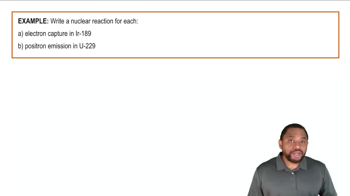Here are the essential concepts you must grasp in order to answer the question correctly.
Nuclear Fission
Nuclear fission is a process in which a heavy nucleus, such as uranium-235, splits into two or more lighter nuclei, along with the release of energy and neutrons. This reaction can be initiated by the absorption of a neutron, leading to a chain reaction that is fundamental in nuclear reactors and atomic bombs.
Recommended video:
Band of Stability: Nuclear Fission
Balancing Nuclear Reactions
Balancing nuclear reactions involves ensuring that the total number of nucleons (protons and neutrons) and the charge are conserved on both sides of the equation. This means that the sum of the atomic numbers and mass numbers of the reactants must equal those of the products, which is crucial for accurately representing the reaction.
Recommended video:
Balancing Basic Redox Reactions
Uranium-235
Uranium-235 is a specific isotope of uranium that is fissile, meaning it can sustain a nuclear fission chain reaction. It constitutes about 0.7% of natural uranium and is used as fuel in nuclear reactors and for the production of nuclear weapons due to its ability to release a large amount of energy when undergoing fission.
Recommended video:
Electron Capture & Positron Emission Reaction Example
 Verified step by step guidance
Verified step by step guidance


